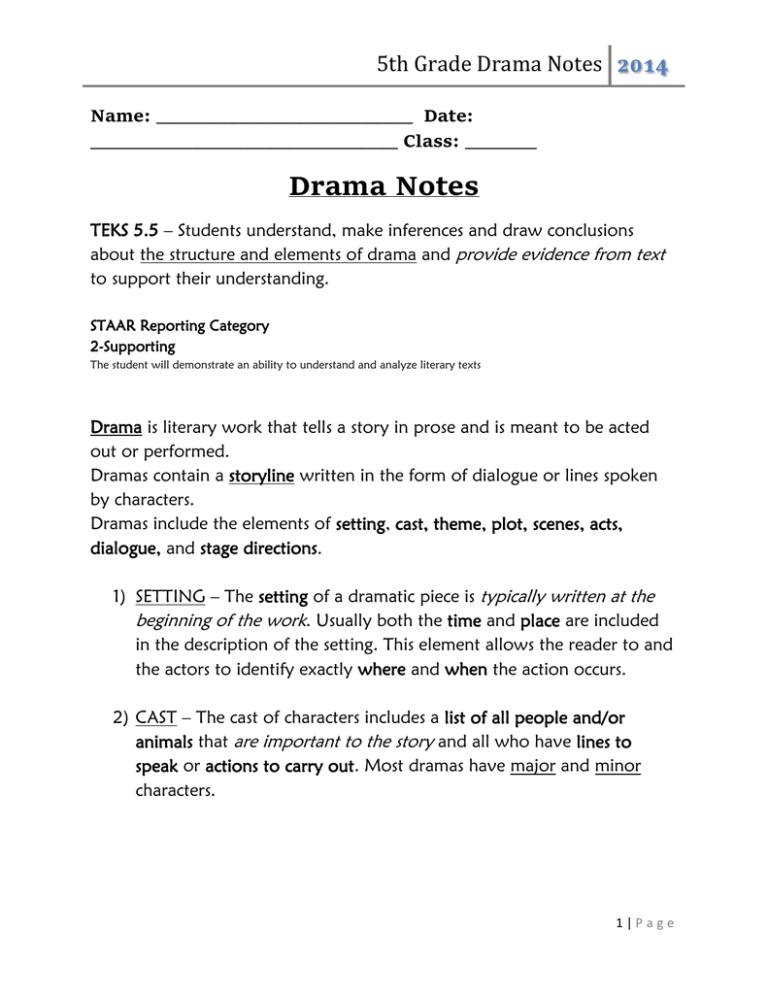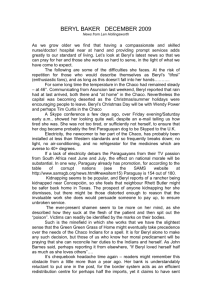5th Grade Drama Notes
advertisement

5th Grade Drama Notes 2014 Name: _________________________ Date: ______________________________ Class: _______ Drama Notes TEKS 5.5 – Students understand, make inferences and draw conclusions about the structure and elements of drama and provide evidence from text to support their understanding. STAAR Reporting Category 2-Supporting The student will demonstrate an ability to understand and analyze literary texts Drama is literary work that tells a story in prose and is meant to be acted out or performed. Dramas contain a storyline written in the form of dialogue or lines spoken by characters. Dramas include the elements of setting, cast, theme, plot, scenes, acts, dialogue, and stage directions. 1) SETTING – The setting of a dramatic piece is typically written at the beginning of the work. Usually both the time and place are included in the description of the setting. This element allows the reader to and the actors to identify exactly where and when the action occurs. 2) CAST – The cast of characters includes a list of all people and/or animals that are important to the story and all who have lines to speak or actions to carry out. Most dramas have major and minor characters. 1|Page 5th Grade Drama Notes 2014 3) THEME – The theme of a drama is similar to that of any literary text. The theme provides the message or lesson the playwright seeks to share with the audience. The theme provides the basic idea of the play and holds the dialogue together through the use of a common meaning or message. 4) PLOT – The plot of a dramatic piece includes the series of events that take place in the drama. The plot is usually structured in acts and/or scenes. a. ACT – An act is a division or part of a drama and is characterized by a change in the stage set or scenery. b. SCENE - Acts can be subdivided into scenes. The setting typically does not change when a new scene is introduced. 5) DIALOGUE – The dialogue of the drama is each word spoken by a member of the cast. Within the dialogue, the audience or reader learns about the relationships, problems, and conflicts [plot] experienced by the characters. 6) STAGE DIRECTIONS – Stage directions are included in the text of dramas and are (typically written in parentheses). These stage directions provide: o asides, words spoken by an actor or character directly to the audience, which are not "heard" by the other characters on stage during a play, o refer to movements of characters, o or tell inner thoughts or feelings of character. Stage directions might also include: o a description of the attire, clothes or apparel, especially rich or splendid garments of the characters o and props, articles or objects that appear on stage during a play, that could be used by the cast. 2|Page 5th Grade Drama Notes 2014 ACT I SCENE 1 Set in 1950’s style diner, “McDenny’s”, in the present day England. BERYL is sitting at the back of a “u” shaped booth. She is tucking into a large burger and reading a gas bill Enter LYNDA, SUSAN and RODERICK LYNDA: (speaking to SUSAN and ROD as they make their way over to BERYL) ...put your back into it man, I said, use some elbow grease, don’t just tickle it, I want to see my face in it... Hi Beryl... BERYL hides the burger under the table BERYL: Oh hi SUSAN: (sits at the table at the left side of BERYL) He was doing his best. ROD: Hi LYNDA: I don’t want to see any smear marks and don’t bend the aerial or I’ll stop it out of your wages. LYNDA and ROD sit to the right of BERYL SUSAN: Lynda, I think you’re being a bit harsh. Hi Beryl LYNDA: If you’re going to do something, do it right that’s what I say. Enter waiter carrying a large portion of fries WAITER: (To BERYL) your large fries Madam LYNDA: Beryl? BERYL: They’re not mine WAITER: Sorry? BERYL: No, you must be mixing me up with someone else. WAITER: (looks around the empty room) BERYL: I didn’t order any. WAITER: Oh, but you did. http://www.comedyplays.co.uk/cpv5/scripts/spf.pdf 3|Page




